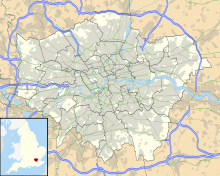Heston Aerodrome
| Heston Aerodrome | |
|---|---|

Heston Aerodrome central buildings, July 1935, looking east
|
|
| Summary | |
| Coordinates | 51°29′15″N 000°23′00″W / 51.48750°N 0.38333°WCoordinates: 51°29′15″N 000°23′00″W / 51.48750°N 0.38333°W |
| Map | |
| Location within Greater London | |
Heston Aerodrome was a 1930s airfield located to the west of London, UK, operational between 1929 and 1947. It was situated on the border of the Heston and Cranford areas of Hounslow, Middlesex. In September 1938, the British Prime Minister, Neville Chamberlain, flew from Heston to Germany three times in two weeks for talks with Adolf Hitler, and returned to Heston from the Munich Conference with the paper referred to in his later "Peace for our time" speech from 10 Downing Street.
Heston Air Park was conceived by fellow pilots and aircraft co-owners Nigel Norman and Alan Muntz in 1928, and it was constructed by their new company, Airwork Ltd. It was officially opened on 5 July 1929, to coincide with hosting the two-day King's Cup air race. By then, the Airwork Flying School had become well established, many privately owned aircraft had moved in, and the Household Brigade Flying Club, also known as the Guards flying club, had moved from Brooklands. Frequent public events helped promote Heston as a major centre of private flying, air displays, public demonstrations of new aircraft types, 'garden parties', air races, and as the starting point for long-distance flight record attempts. The King's Cup race was again staged at Heston in 1931. From the start, the first UK use of a concrete hangar and concrete aprons had already been established. Additional hangars and facilities, and expansion of the airfield, continued through the 1930s.
In September 1931, Heston Air Park was renamed Heston Airport, following provision of customs facilities and ongoing improvements for passenger handling. Night flying facilities were installed and further developed, and in 1932 it was designated as a commercial diversionary airport, often required when Croydon Airport was fog-bound. It is claimed that the central building was the first purpose-built airport control tower, on which all modern control towers are based.
...
Wikipedia

